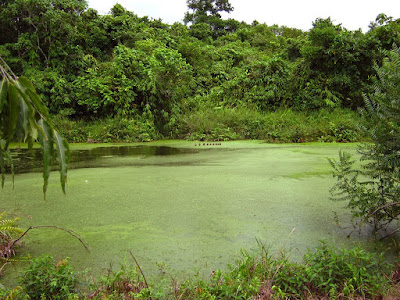Gomantong Caves located at Gomantong Hill inside Gomantong Rainforest Reserve.
The Caves consist of two cave complexes:
1) Black Cave (Simud Hitam)
2) White Cave (Simud Putih)
For centuries, both caves have been producing the prized birds nest for China.
Gomantong Caves entrance is only 3 hours drive from our house in Taman Semarak.
From Gomantong Caves main entrance, it is only a 10 minute trek to the Black Cave on wooden walkway. Surrounding the caves are green rainforest.
When you get the strong smell of bat guano you know you have arrived at the cave entrance of Simud Hitam (Black Cave). A circular wooden walkway goes around the main cave floor. The exit is the same way you entered. Almost all tourist visit the cave follow this circular walk way. But the adventurous will venture away this circular limitation. This is what we want to do in this 2nd visit to the cave - to explore further into the other parts of the cave.
The Black Cave measure approximately 30 meters wide and 100 meters high. Most young Malaysians today avoid this dangerous activity of climbing up a hundred meters to the ceiling of the cave using ropes and rattan ladders to pluck birds nests. This is when the more daring Pilipino and Indonesian come into a great demand in the Birds Nest industries.
Photo above : At the cave top opening, you can see carefully at the right hand side a rope extending all the way down from the hill submit used by birds nest collectors during harvesting. Birds nests harvesting is a risky job.
Most visitors said that it is more accurate to call this Birds Nest Cave a Cockroach Cave. Yes, at the end of the visit most visitors did not see a single birds nest nor even a Swiftlet bird but instead they saw thousand or perhaps millions of these undesirable creatures - the cockroaches. They are everywhere - on the walkway, the ground, the cave walls and on the handrails of the walkway.
After a visit to the cave, many once faint-hearted visitors had achieved a great breakthrough in life - the conquering of a long time phobia - the fear of cockroach. In this Cockroach Cave, the cockroaches there are harmless and afraid of us than we are more afraid of it.
The purpose of the three of us coming here is not to test our courage over the cockroaches. We came here with the
hope of watching how birds nest harvesting are done by by the cave climbers. But we came too late, the officer said that the harvesting season had just finished, it was
Hari Raya Aidilfitri already so the harvesting had to stop because
Hari Raya is a special non-working day. The next birds nests harvesting will be in April next year.
Not anyone can come at any time to get some birds nests here whenever they want. Birds Nest Harvesting here in Gomantong Caves, like other caves, are regulated by the Sabah Wildlife Department to avoid over-exploitation. The collection is done only 3 times per year with licenses issued to collectors who gave the highest tender.
The middle man who won the tender and issued a license to harvest the nests usually has a team to work with. The team compost mainly young men in the early 20. The most highly paid are the climbers (the collectors). Today many of these young climbers are Philippine young men specially contracted from Philippines to do this dangerous job 3 times per year
Raw Birds Nest can fetch up to Rm 2,000 a kilogram. The best quality, the White Nest fetch Rm 5,000 per kilo. After cleaning and removing the bird feathers from the nests, the export price to China can reach as much as Rm 6,000 per kilogram (White Nest Rm 10,000 per kilo). The price constantly increase.
The WWF praised Gomantong Caves as the best managed edible birds nests in the world.
There are four swift species in Sabah :
1) Collocalia Fuciphagus - produce the white nest
2) Collocalia Maximus - produce the black nest
3) Collocalia vanikorensis - produce the moss-like nest
4) Collocalia Esulenta - white-bellied birds
Only 1) and 2) have high nutritional and medicinal value and edible.









.jpg)

























